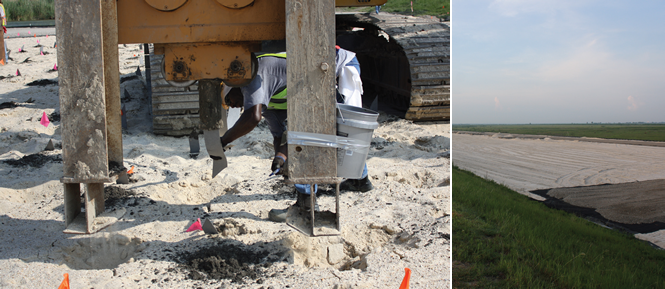
It is an extreme challenge—to shore up, stabilize and add height to huge earthen levees in the Greater New Orleans Hurricane and Storm Damage Risk Reduction System. But the payoff is priceless: these reinforced levees will help prevent future disasters from flood waters by hurricanes like Katrina.
The project led by the US Army Corps of Engineers and its contractors is complex, involving rapid consolidation and increased strength on more than seven miles of earthen levees in record time. How are they achieving this critical goal prior to the 2011 hurricane season?
One important factor in their success is a Colbond product, Colbonddrain® CX 1000. This prefabricated vertical drain provides a conduit for faster pore water dissipation, a major consideration working in soft, marshy soils. Colbondrain accelerates consolidation and settlement time dramatically, allowing the levees to be built much faster.
Colbonddrain was selected for this project by US Wick Drain, a wick drain contractor based in Leland, North Carolina. The company won the bid to work with Archer Western Contractors from Atlanta, the primary contractor. “We decided to use Colbonddrain CX 1000 because it’s a high-quality product and Colbond offered us an excellent value proposal,” said Mark Palmatier, president of US Wick Drain.
Colbonddrain, a 100mm wide geocomposite drain, includes an extruded polymer core fully covered with a filter fabric. Its tensile strength is higher than most wicks and the fabric is thermally bonded to the plastic core in a unique way.
More than nine million linear feet of Colbonddrain now inhabits more than 300,000 holes throughout the LPV 109 levee project, absorbing moisture that consolidates the soil to keep the levees stable. This mammoth installation comes in as the third-largest per linear feet of PVD installed in the US to date.
“It took us more than five months to install the wicks,” explained Palmatier. “And we were working 12-hour shifts six days a week. We even worked some nights. Working from late May through the summer in the middle of the swampy bayou was brutally hot, but it was a great project.”

US Wick Drain deployed half the company’s equipment to complete the job under a tight deadline. Five stitchers (large drain rigs) were used; a metal plate holding the wick was pushed through the soil by a mandrel to anchor it at predetermined depths. Cone penetrometer testing was performed to determine the wick-tip depth.
“This was our first experience with Colbonddrain CX 1000. We’ve used it on several other installations since this project,” said Palmatier.
A COMPLEX PROCESS
The New Orleans levees involved in this project measure 320 feet to 360 feet wide, with elevations ranging from about 18 to 25 feet, and run for approximately 7 miles. Reinforcing and adding height to these earthen levees is difficult, especially in moisture dense swampy areas. The process is multi-layered, using a sand blanket, geotextile fabrics, and rock and wick drains.
It began with geotechnical design, specs and plans created by URS Corporation staff located in Mobile, Alabama. Archer Western took these plans and placed a geotextile separator fabric and a sand blanket 2–3 feet thick to form the base. The layers above the sand blanket include the top of the wick drains, followed by separation fabric, gravel, more separation fabric and clay.

For more information about Colbond products, visit www.colbond-usa.com or call 800-365-7391.











